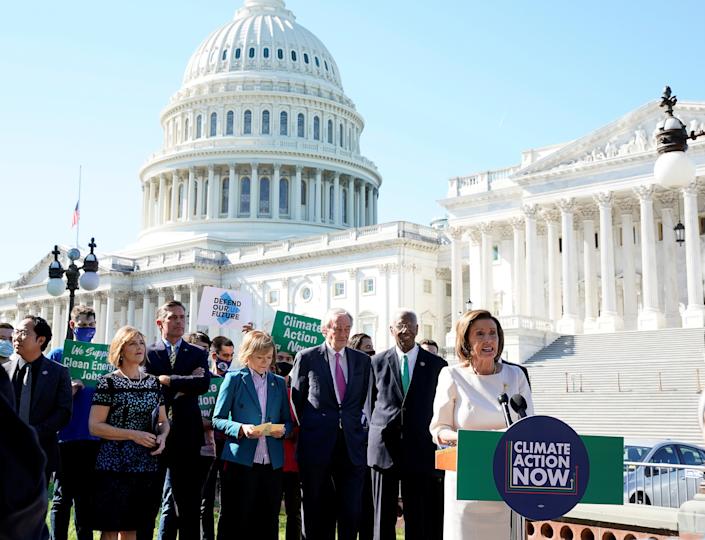Biden emissions pledge hanging by a thread after Manchin’s climate change budget cut

(Yahoo Finance) – Having caved to West Virginia Sen. Joe Manchin’s demand that they strip the forthcoming federal budget of the Clean Electricity Performance Program (CEPP), its biggest provision to combat climate change, congressional Democrats are scrambling to come up with new ways to meet President Biden’s target of cutting greenhouse gas emissions in half by 2030.
Sticking by that emissions pledge, which Biden made in April, is widely seen as an important step toward forging global agreement at the U.N. Climate Change Conference in Glasgow, Scotland, next month. Without it, the U.S. may find itself less able to coax other nations into more aggressively cutting their own emissions that cause global warming, and doing so without the CEPP will be no easy task.
Sen. Tina Smith, D-Minn., who helped devise the program, said Monday that she’d spoken to Biden about the difficulties posed by heading to Glasgow without the CEPP in place.
“He told me last week he just didn’t think he could get there on the clean electricity program,” Smith told CNN. “But rolling back the CEPP — which is a foundation of the president’s action plan — that’s a huge concession. The question on my mind is what are we going to do instead?”
With their hand forced by Manchin, congressional climate change policy leaders have already begun working on another way of meeting Biden’s target, and experts and activists say it’s technically possible.
“If the CEPP were to be abandoned, President Biden and Congressional Democrats must deliver bold NEW investments in other climate priorities to close the emissions gap and meet the President’s international climate goals in the coming days and weeks as the U.N climate negotiations near,” the Sierra Club said in a statement on Saturday. “Such new investments could include historic moves to reduce industrial emissions, advancing rooftop and community solar, increased tax credits to expedite the clean energy transition, grants for states to slash climate pollution, investments in building electrification, and robust new funding for enforcement of the National Environmental Policy Act and the Clean Air Act.”
With the notable exceptions of action on industrial emissions and grants to states for reducing emissions, those policies are already in the legislation. They could, however, get a lot more funding. Smith said on Monday that the Senate is considering increasing the amount of money in a clean energy tax credit package. The CEPP was supposed to cost $150 billion over 10 years, so some of that money could be redirected to other programs — aside from the fact that Manchin and fellow centrist Democrat Sen. Kyrsten Sinema of Arizona forced Biden to scale back his total spending proposal, which includes other causes such as expanding access to child care, from $3.5 trillion over 10 years to $1.9 trillion.
Industrial emissions — for example, the large carbon footprint of cement production because it requires heating materials to very high temperatures — have a tendency to be overlooked, and Biden’s budget does not contain major provisions for addressing them. The Sierra Club put out an analysisWednesday afternoon calling for a revised budget bill to subsidize the adoption of new, low-carbon technologies at energy-intensive factories like those making cement and steel. The group cites a 2019 Center for American Progress report finding that every $10 billion invested in reducing industrial emissions will save 30 million metric tons of carbon per year, which is equal to 0.5 percent of current U.S. emissions.
“There are multiple paths to our 2030 target,” Julie McNamara, deputy policy director with the Climate & Energy program at the Union of Concerned Scientists, told Yahoo News. But, she added, “this is a narrow path and we need everything to go right.”
Losing the clean energy program makes cutting emissions so much harder because it was the only measure aimed squarely at reducing the main cause of climate change: the burning of fossil fuels. The program would have set a benchmark for utilities of increasing the clean energy share of their portfolio, and rewarded those that outperformed the standard and penalized those that fell short.
Congressional Democrats are still planning to include a host of other measures to transition away from fossil fuels, including subsidies for local governments, nonprofit organizations and individuals to buy electric vehicles, rooftop solar panels and energy-efficiency retrofits for buildings. But, according to modeling by Energy Innovation, a climate policy think tank, removing the clean energy program reduces the Build Back Better package’s projected emissions reductions by 20 to 35 percent. And the second most impactful climate policy in the budget proposal is also opposed by the fossil fuel industry and potentially at risk of getting axed: charging a fee for methane — a powerful greenhouse gas — leaked into the atmosphere by natural gas and oil producers.
“The policies that support renewables development are on sure footing, and the policies that address our continued unmitigated and unfettered use of fossil fuels [are not], and we see that continuing to show up again and again,” McNamara said.
The loss of the CEPP is a major blow to Biden’s climate ambitions, but the most effective ways of making up the difference would charge fossil fuel corporations for the social costs of climate pollution, and those face the same political challenges. Over the weekend, there was a brief burst of speculation that a carbon tax might replace the clean power program, and Smith mentioned the possibility to CNN on Monday. That trial balloon burstthe next morning when Manchin flatly stated his opposition to it and Sen. Jon Tester, D-Mont., also expressed reservations.
So Congress will come up with some additional package of tax credits and grants to encourage the adoption of renewable energy and the electrification of transportation, home heating and maybe even industrial processes. Some experts suggest adding grants for aging nuclear power plants to keep them in operation and new funding for reforestation, since plants absorb carbon dioxide, the most common greenhouse gas. But what exactly the bill will include and whether it will get the U.S. to Biden’s goal for Glasgow is unclear.
Congressional legislation isn’t the only way to combat climate change, though. Federal agencies have a lot of power to regulate pollution and affect energy production. The Biden administration already has made several moves to curb greenhouse gas emissions under the president’s existing legal authority, including a new rule restricting the use of hydrofluorocarbons, also known as HFCs, a group of refrigerants that have a powerful warming effect, as well as opening up large swaths of ocean to offshore wind energy production.
More executive branch action could also be coming, especially if Congress doesn’t act to discourage fossil fuel use. In 2007 the Supreme Court ruled that the Environmental Protection Agency has the obligation under the Clean Air Act to regulate carbon dioxide as a pollutant. The Obama administration wrote a rule setting limits on how much carbon power plants could produce, and the Trump administration reversed it. Biden could revive that effort, and he also could issue more stringent new regulations on fossil fuel production. State and local governments also have powerful tools at their disposal, in terms of energy utility regulation and transportation policy.
None of those other means of reducing emissions, however, will happen before world leaders convene in Glasgow on Nov. 1. And that is why Democrats in Congress and environmentalists continue holding out hope for large-scale climate programs to make it into the budget.
“The House has done its job,” said House Select Committee on the Climate Crisis Chair Kathy Castor of Florida at a Wednesday press conference in front of the U.S. Capitol. “We’ve drafted strong climate policies to meet the president’s goal. We’ve ushered a robust bill through our committees. We’re going to keep fighting until that bill lands on the president’s desk.”












